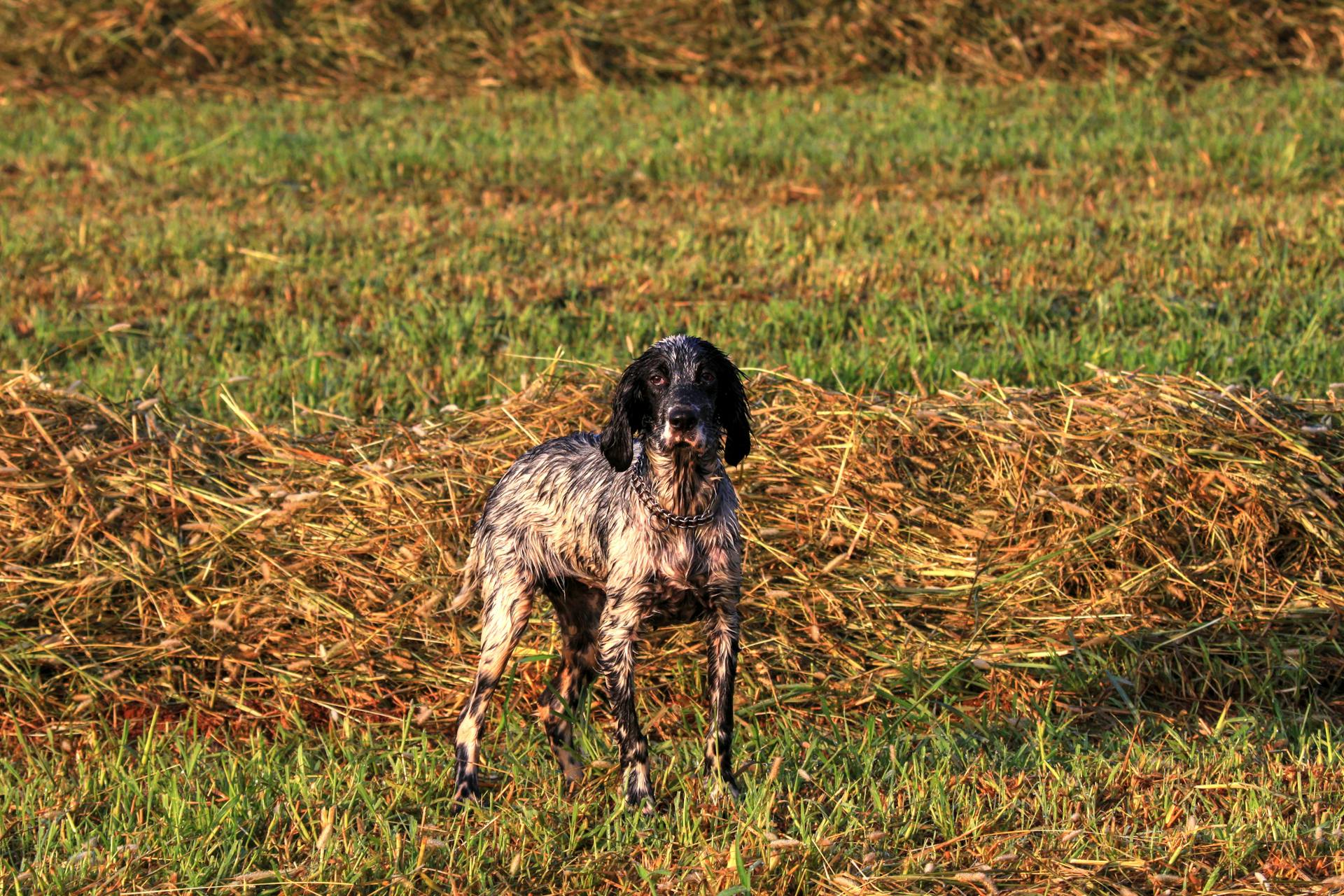
English Setters are a beloved breed, known for their gentle and affectionate nature, but they can be a handful to train if you don't know their quirks.
They thrive on positive reinforcement, so be prepared to reward good behavior with treats and praise.
English Setters are highly energetic and require regular exercise to keep them happy and healthy, ideally 1-2 hours of physical activity and mental stimulation per day.
With consistent training, patience, and love, your English Setter can become a well-behaved companion and hunting partner.
English Setters are prone to eye problems, so regular check-ups with your vet are essential to prevent and detect any issues early on.
Their beautiful, silky coats require regular grooming to prevent matting and tangling, ideally 2-3 times a week.
Discover more: Why Are Labradors so Popular
Dog Care
As you start your English Setter training journey, it's essential to prioritize their physical and mental well-being. Owning a dog is a large responsibility, and you'll need to know what to feed them, how to groom them, and what kinds of health issues they may face in the future.
English Setters need regular exercise to stay in shape, especially when they're young. The ideal situation for an English Setter is life in a house with access to a fenced yard where he can play.
A good schedule for providing your Setter puppy with exercise is crucial. From 9 weeks to 4 months of age, puppy kindergarten once or twice a week is a great way for him to get exercise, training, and socialization, plus 15 to 20 minutes of playtime in the yard, morning and evening.
As your puppy grows, you'll need to adjust their exercise routine. From 4 to 6 months of age, weekly obedience classes and daily half-mile walks will meet his needs, plus playtime in the yard.
English Setters can be prone to chewing and housetraining difficulties, so it's essential to crate train them when they're young. Crate train your English Setter when he's young, and place him in his crate with a sturdy toy for entertainment when you can't be there to supervise him.
To successfully housetrain your English Setter, start early, keep him on a regular schedule, reward him with praise or a treat when he potties outside, keep playtime and potty time separate, and crate him when you can't supervise him.
You might enjoy: 4 Months Dogo Argentino Puppy
Dog Health
Dog Health is an essential aspect of English Setter ownership. English Setters are generally healthy, but like all breeds, they can be prone to certain health conditions.
Some common health issues in English Setters include allergies, hypothyroidism, bloat, deafness, and lysosomal storage disease. These conditions can be managed with proper care and attention.
Allergies in English Setters can manifest as skin issues or digestive problems. Hypothyroidism results from an abnormally low level of thyroid hormone production and can be managed with daily medication.
Bloat is a serious condition that requires immediate veterinary attention. Deafness is relatively common among English Setters and can be challenging for both the dog and the owner.
Here are some key health considerations for English Setters:
Regular veterinary check-ups and early detection are crucial to managing these conditions effectively.
Training and Behavior
English Setters are intelligent dogs that can pick up new commands quickly, but they can also be willful and stubborn at times. Starting obedience training early and continuing for about two years with periodic reinforcement is necessary to ensure good behavior.
Because of their sensitive nature, positive reinforcement is the best approach to training. Harsh methods will only lead to stubbornness and reluctance to follow commands.
English Setters have a strong prey drive and excellent sense of smell, which can cause them to follow their instincts. Early training and socialization are essential to curb these instincts and prevent unwanted behavior.
Here's a summary of exercise needs for English Setters:
Puppies
Getting an English Setter puppy can be a pricey affair, especially if you go through a reputable breeder who has raised the puppy with its mother and siblings.
You'll likely need to get the results of any health checks done on the parents from the breeder.
Going through a breeder will give you a puppy that's likely to be energetic, but they also love cuddles.
You might be able to find an older English Setter through a rescue organization, but they may not have puppies available.
Care
English Setters are intelligent, energetic dogs that require regular exercise to stay happy and healthy. They need at least a half-hour run off-leash in a fenced area or a walk on-leash every day.
Their exercise needs change as they grow, so it's essential to adjust their routine accordingly. Puppies under four months old should start with short playtime sessions in the yard, while older dogs can handle longer walks and runs.
Providing mental stimulation is just as crucial as physical exercise. English Setters love learning new things, so engage them with outdoor games and interactive puzzles to keep them entertained and challenged.
To prevent destructive behavior, crate train your English Setter when they're young. This will keep them out of trouble when you're not around to supervise, and it'll also help with housetraining.
For your interest: When Is the Best Time to Breed a Female Dog
Training
Training an English Setter requires patience, consistency, and positive reinforcement. They can be willful and stubborn, so starting obedience training early and continuing for about two years with periodic reinforcement is necessary.
English Setters are intelligent and can pick up new commands quickly, but they're also sensitive, so positive reinforcement is essential. Harsh training methods will only lead to stubbornness and reluctance to follow commands.
Socialization is vital for English Setters, especially in multi-pet households with small animals. They have a strong prey drive and may follow their instincts, so early socialization can help curb these tendencies.
Here are some key training tips for English Setters:
English Setters thrive on mental and physical stimulation, so providing plenty of exercise and interactive puzzles is essential. A lack of mental stimulation can lead to boredom and mischievous behavior.
English Setters are intelligent and trainable, but they can be prone to separation anxiety. They need a family with a consistent routine and plenty of attention to keep them happy and healthy.
Size
The English Setter's size is an important consideration for potential owners, and it's essential to understand their physical characteristics to provide the best care.
Male English Setters stand between 24 to 27 inches tall at the shoulder, while females are slightly smaller, ranging from 23 to 26 inches.
Their weight typically falls between 55 to 80 pounds for males and 45 to 70 pounds for females, which is a significant range that can impact exercise and nutrition needs.
English Setters are a medium to large-sized breed, known for their elegant and well-proportioned build, making them a visually striking companion.
Their body length is slightly longer than their height at the withers, giving them an elongated, sleek silhouette that's perfect for agility and endurance activities.
Their long, flowing coat requires regular grooming to prevent matting and tangling, especially in areas with feathering such as the ears, chest, abdomen, and legs.
Final Thoughts
If you're considering an English Setter as a pet, be sure to have a large, fenced-in yard for them to play in. They thrive in active environments and need plenty of exercise to stay happy and healthy.

English Setters do well in homes with multiple pets, but you'll need to watch them around smaller animals. This is especially important if you have pets that are easily intimidated.
As long as you're willing and able to keep up with their energy levels, an English Setter can be a fantastic companion for active families or single owners. They're a great choice if you're looking for a pet that will keep you active and engaged.
Exercise and Sports
To get started with exercise and sports for your English Setter, take a look at the dog sports options available.
You can enroll your mixed-breed dog in a canine partner program, which is a great way to get started.
Exercise is essential for English Setters, and they need at least an hour of daily activity to stay happy and fit. You can take your pup on long walks, let them join you on hikes, or play fetch in the backyard.
To give your English Setter a fun workout, consider setting up an agility course in your backyard or signing them up for a training course.
Related reading: How Much Exercise Do Labrador Retrievers Need
Getting Started in Dog Sports
Getting started in dog sports can be an exciting and rewarding experience for both you and your furry friend. You can begin by introducing your dog to various dog sports through training and practice.
One way to get started is to enroll your mixed-breed dog in a canine partner program, which can help you find a suitable sport and partner your dog with a trainer or handler.
There are several dog sports to choose from, each with its own set of titles and abbreviations. Understanding these can help you navigate the world of dog sports and communicate effectively with other competitors and judges.
To determine which sport is right for you and your dog, consider factors such as your dog's breed, age, and energy level, as well as your own interests and goals.
To get started in dog training, it's essential to begin with the basics and gradually build up to more advanced skills and techniques. This will help you and your dog develop a strong foundation and prevent frustration and burnout.
Virtual dog sports and events have become increasingly popular, offering a convenient and flexible way to participate in dog sports from the comfort of your own home or on the go.
Exercise
English Setters have a lot of energy, but they don't have as much as other sporting breeds. They need an hour or more of daily exercise to stay fit and happy.
You can take your English Setter on long walks, let them accompany you on hikes, bring them to the dog park, or play a game of tag or fetch in the backyard.
They are quite athletic; between that athleticism and their intelligence, you'll find the English Setter is great at sports competitions.
You may want to sign them up for a training course or just set up an agility course in the backyard.
Owning a Dog
Owning a dog is a large responsibility. You'll need to know what to feed them, how to groom them, and what kinds of health issues they may face in the future.
English Setters are energetic dogs and need regular exercise to stay happy and healthy. A daily walk and playtime in the yard or park is a must.
You'll also need to consider the cost of owning a dog, including food, vet bills, and supplies. Owning a dog can be expensive, so it's essential to factor this into your budget.
English Setters are prone to certain health issues, such as hip dysplasia and eye problems. Regular check-ups with the vet can help identify these issues early on.
Grooming is also an essential part of dog ownership, as English Setters have a thick coat that needs regular brushing. A good brush can help prevent matting and tangling, and make bath time a breeze.
Explore further: Owning a Shiba Inu
Breed Information
The English Setter is a breed that thrives on exercise, weighing between 45-80 pounds. They're built for active families and singles who have backyards to run around in.
Their size and energy level mean they need regular physical activity to stay happy and healthy. This can include activities like agility, rally obedience, and therapy work.
English Setters are known for their gentle and sociable nature, making them a great choice for families with children. They're also excellent watchdogs, alerting their family to approaching visitors while welcoming guests with open paws once formally introduced.
Breed Overview
The English Setter breed is a real showstopper, weighing in at 45-80 pounds, and coming in a variety of colors including white, orange belton, lemon belton, liver belton, blue belton, and tri-color.
This breed is perfect for active families and singles, as they love to run around and play in backyards. They're also great companions for skilled hunting enthusiasts.
The English Setter has a rich history, dating back to the 15th century, and is one of the oldest gun dog breeds. They were originally bred in the United Kingdom as a hunting dog, and were developed by crossing Pointer breeds with Spaniels.
English Setters are known for their gentle and sociable nature, making them a great choice for first-time dog owners who want a beautiful and sweet companion. However, they do require regular exercise to keep them happy and healthy.
Their athleticism shines through in activities like agility, rally obedience, and therapy work, and they have a versatility that captivates all who meet them. They're also natural hunters, with a keen sense of smell and a love of chasing birds.
Additional reading: Orange Belton English Setter
National Breed Clubs
National Breed Clubs are a crucial part of a breed's identity and recognition. The English Setter Association – www.englishsetterassociation.co.uk is the British national breed club.
The English Setter Association of America - www.esaa.com is the US national breed club for the English Setter.
CKC, FCI, AKC, UKC, KCGB, ANCK, NKC, NZKC, APRI, and ACR are all organizations that recognize the English Setter breed.
The AKC Sporting Dog Group and KCGB Gundog Group are the two groups where the English Setter is classified.
The AKC Popularity Ranking of the English Setter is 94.
Expand your knowledge: American Kennel Club Lancashire Heeler
Frequently Asked Questions
Can English Setters be off leash?
English Setters are generally not reliable off-leash due to their strong prey drive, which can lead to ignoring commands in tempting situations. Off-leash training requires extra attention and consistency to help them develop self-control.
Can you crate train an English Setter?
Yes, English Setters can be crate trained with patience and positive reinforcement, providing a safe and secure space for your puppy. Learn how to crate train your English Setter puppy successfully with our expert guide.
What are the cons of an English Setter?
English Setters require constant companionship and can become destructive if left alone for extended periods. They also tend to be stubborn, making them a challenging breed for inexperienced owners.
Featured Images: pexels.com


